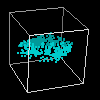
Astronomy and Astrophysics
Monday
Home
Links
Glossary
Monday
Tuesday
Wednesday
Thursday
Friday
Create Report
Drop the Ball
How long does it take to fall?
Materials needed: Each team will need a ruler, a ball, and a stopwatch.
Objective: Students should measure how long it takes to drop a ball from a height of 2 meters, and compare it to a model based on a constant acceleration at -9.8 m/s/s.
Procedure: Drop a ball from a height of 2 meters, measuring how long it takes to hit the ground.
- Do you always get the same time?
- What are some of the errors that could affect your measurements?
- How can you change your experiment to control your error?
- How many measurements are
enough ?
After measuring how long it takes (experiment), compare it to theory. Theory states that the ball will accelerate at a rate of 9.8 meters per second per second towards the ground. How would you go about comparing this theory to your measurement to see if they agree? You need to build a model. A model is a set of computations that allows you to make a prediction from a theory. This can be compared with the observed results of your experiment, to test the theory.
- a=-9.8 m/s/s
- aceleration is the rate of change of velocity:
D v a = ----- D t - velocity is the rate of change of position:
D y v = ----- D t - We can try to calculate this backwards by assuming that if we consider a short enough period of time, the velocity doesn't change much. (This is called Euler's Method).
D y = v D tD v = a D t - A spreadsheet such as Excel can make this easy to calculate. Put in values in excel for your initial conditions (how fast is the ball miving right before you drop it? How high is it? What is the acceleration?) and calculate what the height and velocity are a small time later (and a small time after that, and a small time after that) using the above equations.
- How long does the model take to hit the ground?
Analysis: You have now performed an experiment to measure the time it takes to drop a ball from 2 meters, and you have modeled the theory of a falling ball to predict the time it takes. Do your theory and experiment agree? What are some possible sources of error? What factors might you need to take into account? How could you solve your model more accurately?